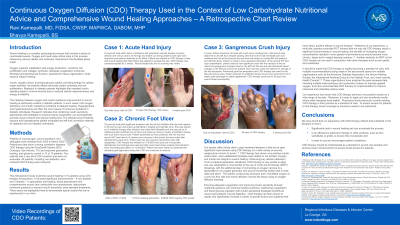Case Series/Study
(CS-071) Continuous Oxygen Diffusion (CDO) Therapy Used in the Context of Low Carbohydrate Nutritional Advice and Comprehensive Wound Healing Approaches – a Retrospective Chart Review

Wound healing is a complex physiological process that involves a series of coordinated events. Oxygen and insulin play critical roles in this process, influencing various cellular and molecular mechanisms facilitating tissue repair.
Oxygen supports metabolism and energy production, which are crucial for cell proliferation and collagen synthesis. Adequate oxygenation enhances fibroblast and keratinocyte function, which is essential for tissue regeneration, while hypoxia impairs healing.
Equally critical, insulin promotes glucose uptake, providing energy for cellular repair activities. Its anabolic effects stimulate protein synthesis and cell proliferation. Research in diabetic patients highlights that impaired insulin signaling leads to chronic wounds due to reduced cellular responsiveness and energy availability.
The interplay between oxygen and insulin resistance improvement in wound healing is particularly evident in diabetic patients. In such cases, both oxygen deficiency and insulin resistance contribute to delayed healing. Hyperglycemia and hyperinsulinemia are often the core causes of numerous problems in diabetic individuals. Research indicates that combining insulin sensitivity approaches with strategies to improve tissue oxygenation can synergistically promote wound closure and reduce healing time. The connection between delayed wound healing, hypoxia, and hyperglycemia was evaluated, and the left foot connection is relevant for people with diabetes and non-diabetic individuals.
Methods: This retrospective study examines wound healing in 15 patients using CDO therapy. Thirteen –– eight non-diabetics and five diabetics –– showed significant improvements in granulation and healing. Sharp debridement and comprehensive wound care, particularly low-carbohydrate, high-protein nutritional guidance to improve insulin sensitivity, were standard treatments. Patient characteristics and glucose levels were analyzed.
Results: Patients of varying ages, wound durations, and etiologies were reviewed from 2022 to 2024. Preliminary data show a strong correlation between CDO therapy and improved granulation, healing, and glycemic control in 13 of 15 patients. Two patients had a very short CDO duration and were not evaluable. All patients, including non-diabetics, who received CDO therapy were analyzed.
Discussion: Oxygen and insulin are integral to wound healing, influencing key cellular pathways. Ensuring adequate oxygenation and improving insulin sensitivity through nutritional guidance can enhance healing outcomes. Optimizing oxygenation and blood glucose regulation with insulin-sensitizing strategies benefits all wound care patients, not just diabetics.

.jpg)